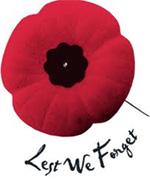The "Poppy"
Posted by John Borst
on Nov 01, 2010
 Each November, Poppies blossom on the lapels and collars of over half of Canada’s entire population. Since 1921, the Poppy has stood as a symbol of Remembrance, our visual pledge to never forget all those Canadians who have fallen in war and military operations. The Poppy also stands internationally as a “symbol of collective reminiscence”, as other countries have also adopted its image to honour those who have paid the ultimate sacrifice.
Each November, Poppies blossom on the lapels and collars of over half of Canada’s entire population. Since 1921, the Poppy has stood as a symbol of Remembrance, our visual pledge to never forget all those Canadians who have fallen in war and military operations. The Poppy also stands internationally as a “symbol of collective reminiscence”, as other countries have also adopted its image to honour those who have paid the ultimate sacrifice.This significance of the Poppy can be traced to international origins.
The association of the Poppy to those who had been killed in war has existed since the Napoleonic Wars in the 19th century, over 110 years before being adopted in Canada. There exists a record from that time of how thickly Poppies grew over the graves of soldiers in the area of Flanders, France. This early connection between the Poppy and battlefield deaths described how fields that were barren before the battles exploded with the blood-red flowers after the fighting ended.
Just prior to the First World War, few Poppies grew in Flanders. During the tremendous bombardments of that war, the chalk soils became rich in lime from rubble, allowing “popaver rhoes” to thrive. When the war ended, the lime was quickly absorbed and the Poppy began to disappear again.
The person who was responsible more than any other for the adoption of the Poppy as a symbol of Remembrance in Canada and the Commonwealth was Lieutenant-Colonel John McCrae, a Canadian Medical Officer during the First World War.
SOURCE:http://legion.ca